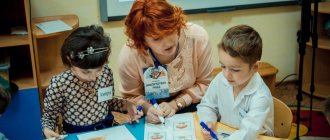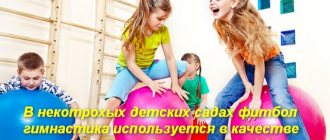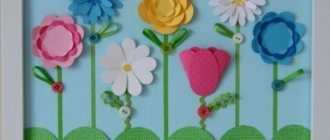MAGAZINE Preschooler.RF
The use of layouts in preschool educational institutions as an innovative technology for the cognitive development of preschool childrenAuthor: Pastukhova Lyudmila Ivanovna Educator, first qualification category MADOU “Kindergarten No. 48” Sverdlovsk region, Verkhnyaya Pyshma
According to the requirements of the Federal State Educational Standard, the subject-spatial environment must provide the opportunity for communication and joint activities of children and adults, and ensure the maximum realization of educational potential. Mandatory equipment includes materials that activate children’s cognitive activity.
Along with traditional methods, innovative pedagogical technologies are used for the intellectual development of preschool children. One of the promising technologies is prototyping.
Layout – a reduced model of an object (forest, mountains, field, lake, volcano, solar system, etc.).
The main characteristic of a model is that it reflects, contains the essential features of nature, and reproduces in a convenient form the most significant aspects and features of the modeled object.
I relied on the experience of Nadezhda Aleksandrovna Korotkova, who distinguishes the following types of layouts:
- floor, and then it has larger structural volumes
- desktop, then the size is limited by the size of the table or part of it
- podium (on special podium stands)
- wall in the form of three-dimensional subject paintings with a foreground subject plan and a background picture.
The use of game layouts in a subject-spatial environment meets the principle of integration of educational areas:
- Promote children's speech development. When working with the model, children describe, compare, talk about various phenomena and objects of nature, reason, thereby expanding their vocabulary.
- There is a close connection between the use of layouts and FEMP. In the process of work, children consolidate such mathematical concepts as space, quantity, size, etc.
- Layouts are of great importance in the development of children's play activities. The layout is considered by children as a play environment where various game plots can be developed, which contributes to the development of communicative initiative in children.
- The use of layouts plays a huge role in the cognitive development of children. The use of layouts on various topics increases the level of curiosity and cognitive interest.
- Layouts create favorable conditions for the sensory development of children: working with materials of different texture, quality, and shape promotes the development of external senses and activates fine motor skills of the hands.
- Layouts in artistic and aesthetic development help children highlight details, color, texture.
Any type of educational activity with children at all its stages requires competent organization and leadership from the teacher. Layout is no exception. The teacher highlights the main stages of work on creating and using a particular layout.
In the process of developing a game with layouts, the following tasks are solved:
- conditions are created to enrich children's ideas about the world around them.
- cognitive interest in living nature, emotional responsiveness and curiosity develops
- skills of correct behavior in nature are formed
- goodwill, responsiveness to the natural world, and careful attitude towards it are fostered.
The following forms of working with the layout are used:
- educational and research activities
- play activity
- productive activity
Methodological techniques for working with the layout:
- examination
- conversation
- reading fiction
- writing short stories
- didactic games.
In early preschool age, children are just beginning to form ideas about living nature. Simple layouts and models created by the hands of teachers form initial ideas about natural objects. But it is not the presence of the layout that shapes it, but the ability to communicate with it, the game. With younger preschoolers, work involves examining finished products and manipulating them. A conversation about nature or a natural object that the model depicts.
In the life of older preschoolers, director's play with small toys occupies a large place, when the child creates an imaginary situation, invents an event with characters, identifying himself with them, performing one of several roles, and modeling real social relationships in a playful form.
A model is a type of children's activity that helps to consolidate ideas about the natural world, allows one to transform acquired knowledge into play, saturating children's lives with new impressions and stimulating children's creativity. The layout is the result of constructive and creative activity and a very attractive playing space. Kids love playing with these layouts! The work of making models is labor-intensive, but very interesting!
I present some of the models that I made for my students. They are made of various materials. Layouts are multifunctional and their use in work is multifaceted, which makes it possible to solve many problems.
- Layout “On the roads and streets of the city” . The layout represents the roadway and parts of the street. Contains models of buildings and cars. It's two-sided. On the other side
"park" , "streets" .
- Layout "Waterfall"
- Africa layout
- Layout "Garden"
- Layout "Village Compound"
- Layout "World of Insects"
- Layout "Antarctica"
- Layout "Russian hut"
- Model “Water cycle in nature”
- Layout "In the world of dinosaurs"
- Layout "Forest floors"
- Layout "Fairy Tale on the Carpet"
Thus, the use of models in working with children is one of the innovative technologies that contribute to the formation of gaming skills, search activity and cognitive activity of each child. I am convinced that the use of layouts in preschool educational institutions will take its rightful place in the process of cognitive activity of preschool children.
Used Books:
- Nishcheva N.V. Subject-spatial developmental environment in kindergarten. Principles of construction, advice, recommendations / Nishcheva // Childhood - Press. – 2010.
- Korotkova N. A. Educational process in groups of children of senior preschool age. – M.: LINKA – PRESS, – 2007.
- Mikhailenko N. Ya., Korotkova N. A. Organization of story-based games in kindergarten. M.: "Gnome and D" , - 1997.
- Mikhailenko N. Ya., Korotkova N. A. How to play with a child. M.: Academic project, - 2001.
| Next > |
How to make an old hut
To create a model of an ancient hut, you first need to familiarize yourself with historical documents that describe the appearance of the Slavic home. Usually this is a log house, which was formed from logs that were laid in a certain sequence. The main feature of a village hut is its painted windows with beautiful shutters. In accordance with these data, it is possible to imagine exactly what a Russian hut looks like, and, therefore, it will be possible to develop a reliable layout.
Required materials and tools
To make a peasant hut you need the following tools and materials:
- office white paper;
- glue with a brush or glue stick;
- Double-sided tape;
- cardboard;
- gouache brown, gray and black;
- colored paper for decoration;
- thick and thin brushes;
- cardboard box;
- scissors, ruler and simple pencil.
Other finishing materials will be needed if a complete composition with a yard and trees is to be formed.
Step-by-step assembly of a detailed layout with step-by-step photos
The principle of assembly and formation of individual parts can be described in the following algorithm:
- Each sheet of white paper should be divided into 3-4 equal parts along the short side. You will get wide stripes. It is necessary to form tubes from strips, which are twisted into several layers and glued with PVA glue. Using double-sided glue, glue 4 tubes perpendicularly to the cardboard box, which will become the support of the roof in the future and will help determine the parameters of the hut. Further along the supports in tiers you can glue other paper tubes to each other.
- When the walls almost cover the vertical elements, you can stop. Now the white “logs” can be painted with brown gouache. You need to wait until it dries completely. While this is happening, you can begin making the roof.
- Prepare a sheet of cardboard and fold it in half to form an exact bend. Cut strips 3-5 cm wide from dark colored paper (black, brown). Form waves on one side of each strip, cutting them out with scissors. Moving from the central fold on the cardboard sheet, glue the wavy strips to the very edges. On one side you can glue a pipe, which can be easily made from a cardboard strip.
- Now you can glue the roof to the base of the walls. The holes that are formed on the sides can be sealed with triangles made of colored cardboard, which are easily attached to the base using double-sided tape.
- The next stage will be the production of windows with carved elements and doors. These parts are easy to make from colored paper. The base of windows and doors is glued to the “logs”.
- This way you get a beautiful log hut made of paper. The work will take about 3 hours. But making such a model will be a pleasant experience for both the child and the parent.
If you expand the composition, the layout of the hut with a yard will look like this.
Plain paper is also used to make fences, trees, and interior buildings.
Udmurskaya hut
The Udmurts are a people with a rich history. Their homes are quite similar in design and furnishings to Russian huts. A distinctive feature of the houses was their decoration - brightly painted textiles. The main decoration of the house was always a huge stove and painted chests in which “family wealth” was stored.
Open model of an Udmurt hut:
Tatar hut
The Tatars' homes were also decorated in accordance with religious characteristics and the foundations of Eastern culture. Outwardly, there is no difference from the decoration of a Russian hut, but in most families there was a clear division of housing into male and female halves. At the same time, the center of the composition is a large white stove and a bright tactile design with oriental motifs.
Expanded model of a Tatar hut:
Russian traditional
The Russian folk hut has the main feature of an always clean, whitewashed huge stove, which was the center of the entire house. Additionally, it was painted with paints to create bright accents in the interior of a simple house.
How to create an open model of a Russian hut with your own hands from cardboard:
Applications for children
The model of a hut for a kindergarten can be a regular appliqué. At the same time, there are several options for making crafts of this type, where the main feature is a certain level of complexity. The simplest application of a Russian hut:
- Prepare several identical strips of brown paper. The façade (base) of the hut will be formed from them.
- You will need a triangle, the base of which will be the same length as the strips for the facade.
- 2 rectangles that will become windows. And 1 more rectangle is narrower, but long - a pipe.
Next, all the elements are glued to a sheet of cardboard as follows. In the older group of kindergarten, you can use the same example of appliqué, but with more complex elements - carved shutters and intricate roof framing. You can complement the picture with other elements - trees, a bench, a well.
Cutting templates
You can print a ready-made template with all the necessary colors. The workpiece will only need to be glued together, forming the desired shapes. Examples of cutting templates:
- A detailed sketch, the assembly of which requires certain skills and knowledge.
- A simple cutting template consisting of 2 parts.
- Template for making a flat swing house.
You can prepare a template for cutting yourself if you have drawing skills.
Design and decoration ideas
An open cardboard hut is usually filled with furniture and textile elements. This is a mandatory point when making a model of a home. What can be used in the decorating process:
- Usually all furniture is made of cardboard and then painted with gouache.
- You can make curtains for the windows from light colored fabric. The same principle is used to make a tablecloth for a table and a bedspread for a bed.
- The main object - a white stove - can also be made from cardboard, but it is better to use polystyrene foam.
- You can lay a bunch of branches near the stove. And you can put finely broken branches in the oven itself.
- The table can be decorated with a samovar, the shelves with “clay” jugs. The dishes can be made from plasticine, which it is then advisable to open with glue or varnish.
Making household utensils, furniture and selecting textiles is a rather interesting process of arranging the home of the Slavs. Additionally, you can even build a “red corner” in the hut in order to accurately follow historical data.
There are various schemes according to which you can create a paper model of a hut of any nationality. The main thing is to make historical inquiries before starting work. The most interesting thing is to make an open model of the inside of the hut. Here you can show all your imagination and skill. Children will especially enjoy the process of working on such a product.









